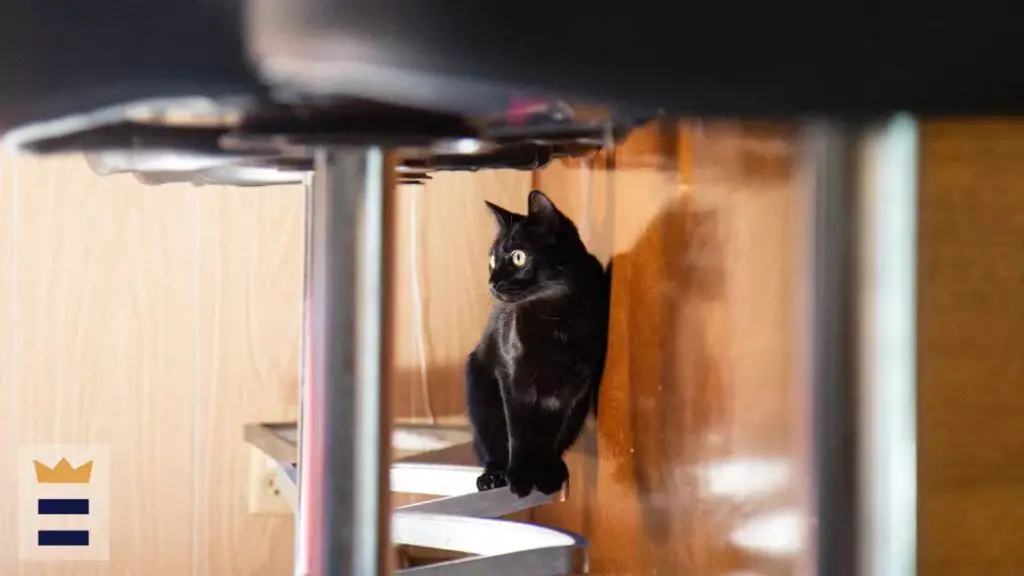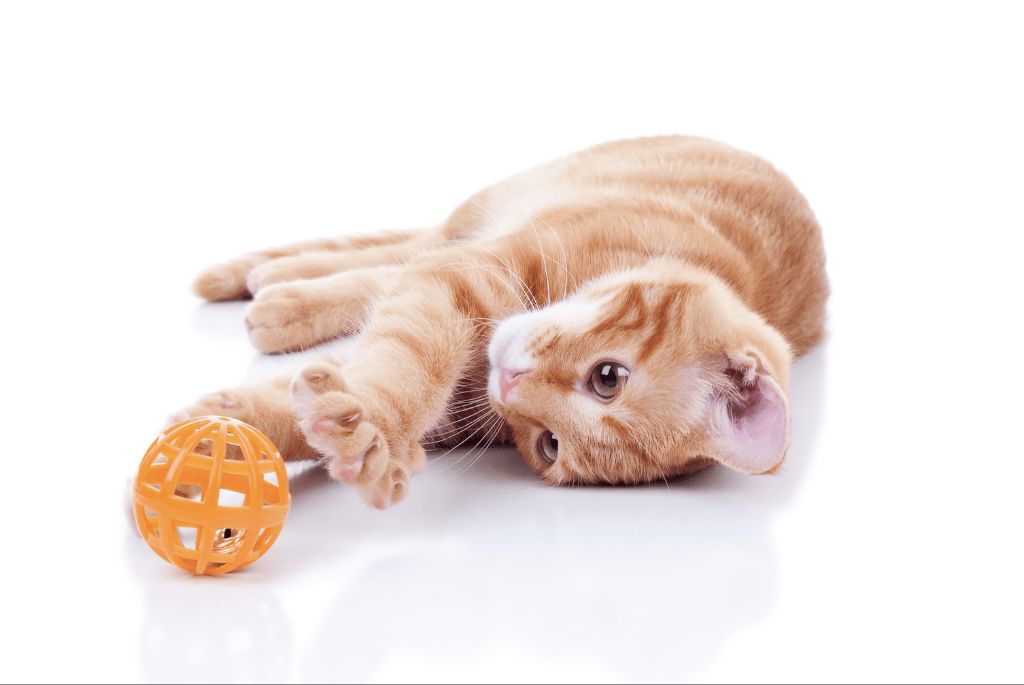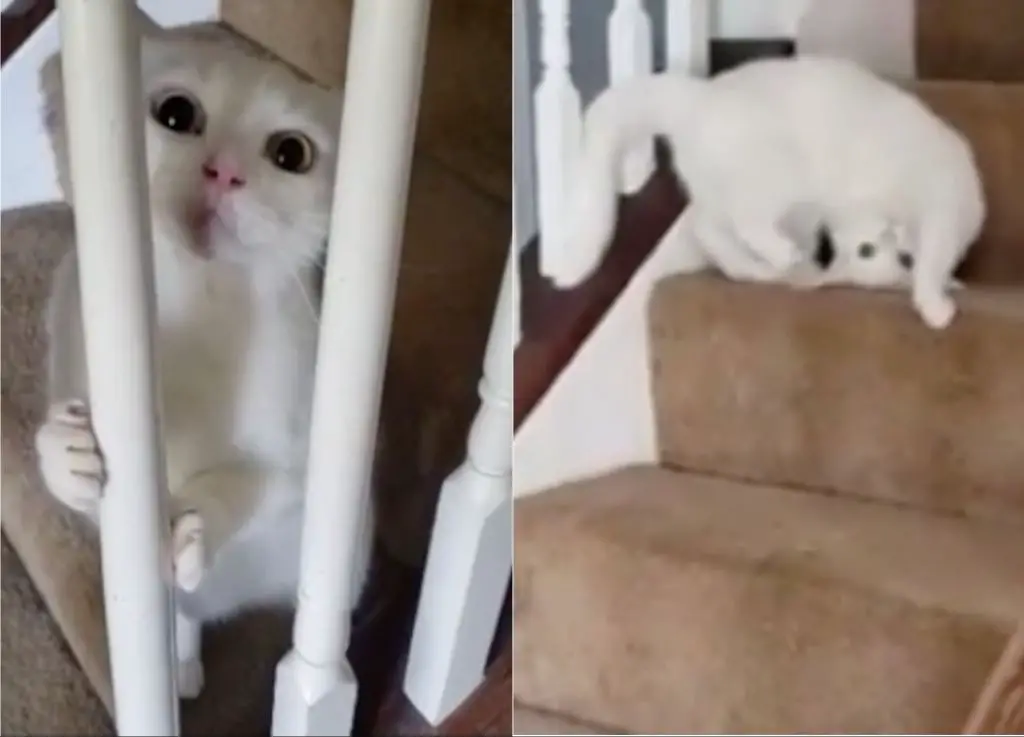What Are Cat Zoomies?
Cat zoomies refer to sudden bursts of frantic energy and excitement in cats. During a bout of zoomies, a cat will race around the house at top speed, jumping on and off furniture, climbing curtains, and even running in circles (Vet Voice). This hyperactive behavior typically lasts for a few minutes, after which the cat will calm down and relax.
The zoomies are characterized by your cat acting like “a mad fool” and displaying behavior not typical for them. You may see exaggerated running, hopping, rolling, jumping, spinning, tail chasing, and other erratic movements as they burn off pent up energy (Four Paws). It’s as if something suddenly possesses your cat to act crazy and wild.
Zoomies most often occur in shorter bursts under 10 minutes. But some cats may experience extended periods of hyperactivity lasting up to 30 minutes or longer. Kittens and younger cats under 3 years old tend to have more frequent and longer zoomie sessions.
Why Do Cats Get the Zoomies?
There are a few main reasons why cats tend to get the zoomies:
Pent up energy – Cats sleep for the majority of the day, conserving energy for short bursts of play and activity. Since they build up energy while resting, they need to let it out through high-energy play like the zoomies (Source).

Hunting instinct – Zooming around at high speeds allows cats to act out their natural hunting behaviors and instincts. The quick zooms and darting movements mimic the way cats would chase prey in the wild (Source).
Playfulness – Zoomies are often a sign that a cat is feeling playful and energetic. The fast running and rolling on the floor shows their exuberance. Kittens especially will get the zoomies when they want to play (Source).
When Do Cat Zoomies Usually Happen?
Cat zoomies often happen at predictable times, though they can occur randomly as well. Some of the most common times for zoomies to strike include:
At night – Many cat owners report zoomies happening in the late evening or at night. Scientists theorize this is due to cats being naturally crepuscular, meaning more active at dawn and dusk. With indoor cats, zoomies at night may simulate this natural tendency.
In kittens and younger cats – Zoomies are very common in kittens and younger cats under 3 years old. Their youthful energy bursts out during bouts of frenzied zooming. As cats mature, zoomies may become less frequent.
After eating – Some cats get the zoomies right after eating a meal, especially in the morning or evening. Having a full stomach seems to energize them into a bout of wild zooming.
After using the litterbox – Many cat owners report zoomies happening right after their cat uses the litter box, especially after a bowel movement. The reason is unclear, but may relate to feline instincts to cover and hide waste.
Normal vs. Concerning Zoomies
Cat zoomies are usually a normal behavior, simply expressing a cat’s natural energy and instincts to run and play. Most cats will have short bursts of zoomies that last for 5-10 minutes, then settle down and relax afterwards. This is considered normal cat behavior.
However, obsessive or excessive zoomies can be a sign of stress, anxiety, or other medical issues. Problematic zoomies may last for extended periods, happening multiple times a day or throughout the night. The cat may seem unable to settle down and obsessed with constant activity. This can lead to destructive behaviors like knocking over furniture, scratching floors and walls, and exhibiting aggression.
According to veterinarians, signs of problematic zoomies beyond their duration include https://www.insider.com/guides/pets/cat-zoomies:
- Zooming when the cat should be resting or sleeping
- Inability to calm down afterwards
- Destroying property during zooming
- Aggression towards humans or other pets
- Vocalizing excessively while zooming
- Zooming multiple times a day
If your cat’s zoomies seem excessive or problematic, discuss it with your veterinarian as it could signify an underlying medical or behavioral issue needing attention.
How to Manage Your Cat’s Zoomies
While zoomies are a natural behavior for cats, excessive or disruptive zooming can be frustrating. Here are some tips for managing your cat’s zoomies:
Schedule interactive playtime before times when your cat tends to zoom, such as first thing in the morning or right before bed. Try playing with toys like feather wands and laser pointers to get their energy out.

Provide puzzle feeders, treat balls, scratching posts and toys that encourage active solitary play throughout the day. Rotating toys can help keep your cat engaged and stimulated.
Catproof areas like lamps, televisions or houseplants that could be knocked over during zoomies. Block access to unsafe areas and provide plenty of sturdy cat furniture and scratching posts.
Consider getting a second cat so they can zoom and play together. Cats can help provide enrichment for each other.
Try calming supplements, pheromone diffusers or CBD oils made specifically for cats if zoomies are excessive.
Make sure your cat is getting adequate nutrition and isn’t exhibiting zoomies due to an underlying medical issue. Check with your vet if needed.
Stay patient – kittens and younger cats are especially prone to zooming while they have excess energy. Consistency and training helps curb zoomies over time.
Fun Facts About Cat Zoomies
While cat zoomies may seem mysterious, there are some interesting fun facts and trivia surrounding this quirky feline behavior:
The Guinness World Record for the fastest zoomies sprint is held by a cat named Jake from Michigan, USA. He reached a top speed of 31 mph during a zoomies burst in 2013.1

Some cats engage in marathon zoomies, sprinting around the house at top speed for up to 30 minutes without stopping.2 This is especially common in younger cats full of energy.
Zoomies most often occur between 6-10 PM, when cats become their most active.3 Late night zoomies are also common as cats wake up ready to play.
During zoomies, a cat’s heart rate can go as high as 240 beats per minute, nearly triple their normal relaxed heart rate.4 This allows their remarkable sprinting ability.
Some experts believe zoomies help cats relieve stress and make use of pent up energy. The random sprinting and playing may provide mental stimulation as well.3
Theories on the Purpose of Zoomies
There are several theories as to why cats experience sudden bursts of frantic energy known as the zoomies.
One common theory is that zoomies are simply a way for cats to release pent-up energy. Cats sleep for the majority of the day, so when they become suddenly active, they have a surplus of energy to expend. Zoomies allow them to run around and burn off that excess energy in a burst of activity.
Another possible reason is that zoomies allow cats to practice and sharpen their hunting skills. The quick, darting movements and pounces they exhibit during zoomies mimic the moves they would use to catch prey in the wild. Zoomies may be a way for domestic cats to keep their predatory instincts primed even when they don’t need to hunt.
Some experts believe cats experience zoomies as a way of communicating with their owners. The chaotic behavior gets the owner’s attention, and the cat may even initiate play with the owner during or after a bout of zoomies. So in some cases, rapid sprints around the house could be a cat’s way of telling the owner that they want to play and interact.
While the exact purpose is unknown, most researchers believe zoomies are a harmless behavior that allows cats to satisfy natural urges. As long as they don’t last too long or pose a safety risk, owners can usually enjoy the entertaining antics of their cat’s zoomies.
When to See the Vet About Zoomies
While zoomies are normal feline behavior, excessive or obsessive zooming can sometimes indicate an underlying medical issue. According to Hill’s Pet Nutrition[1], if your cat’s zoomies seem anxious, last for extended periods, disrupt normal behavior, or happen along with other symptoms, it’s a good idea to consult your veterinarian.
For example, a dramatic increase in zooming activity could point to hyperthyroidism, which speeds up a cat’s metabolism. Zooming coupled with frequent urination or thirst may signal diabetes or kidney disease. And zooming after using the litter box could mean a urinary tract problem.
Kittens and older cats are more prone to medical conditions that lead to obsessive zooming. So if your young or senior cat suddenly develops intense zoomies, a vet visit can help rule out illness. In short, trust your instincts – you know your cat best. If their zooming seems out of character, better safe than sorry. Your vet can examine your cat and determine if zoomies stem from an underlying condition.
[1] https://www.hillspet.com/cat-care/behavior-appearance/what-are-cat-zoomies
Zoomies in Other Animal Species
Cats are not the only animals known to experience the sudden bursts of frantic energy known as zoomies. Dogs also commonly get the zoomies, which are sometimes referred to as “frenetic random activity periods” or FRAPs in canines [1]. Dogs will often run around the house at top speed, jump on furniture, spin in circles, bow playfully, and engage in other energetic behaviors during a zoomies episode.

Zoomies are also seen in small mammals like rabbits, ferrets, and guinea pigs. These petite pets will suddenly start racing around their enclosure, hopping, leaping, and dancing about. Bird owners may witness their feathered friends getting zoomies too, flitting wildly around their cage.
Though less common, zoomies have even been observed in larger animals like horses and elephants. Videos online show young elephants galloping joyfully around their enclosures. So while cats and dogs are the most prone to frantic bursts of energy, the zoomies can strike any animal!
The Joy and Entertainment of Cat Zoomies
Few things are more enjoyable for cat owners than witnessing their beloved feline erupt into a bout of the zoomies. Cat zoomies provide endless entertainment as kitty zips manically around the house, jumping on and off furniture with reckless abandon. While the behavior may seem bizarre or concerning at first, most experts agree that zoomies are a sign of a happy, healthy cat just burning off excess energy in a playful way.
As cats have evolved as predators designed for short bursts of intense physical activity like hunting, it’s natural for them to need periodic high-energy releases. Zoomies allow cats to tap into their inner hunter and hone their survival skills through play. Owners get to delight in watching their cats revert to kitten-like playfulness as they zoom around batting toys, pouncing on objects, leaping to great heights, sliding across slippery floors, and even playfully attacking owners’ ankles or hands. After tuckering themselves out, cats typically return to their normal composed selves and curl up contentedly for a nap.
So while the zoomies may catch owners off guard at times, try to relax and enjoy the show. Let kitty burn off steam, unless she’s being too rough or destructive. Laugh and take photos or videos to share the hilarity. Remember that seeing your cat erupt into spontaneous play is a sign she feels safe, healthy, energetic, and bonded enough to show her silly side. With the right perspective, zoomies become less a bizarre behavior and more a delightful glimpse into your cat’s carefree inner kitten. Just sit back and enjoy the entertainment!

